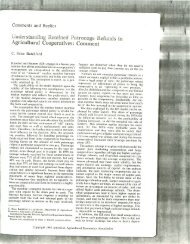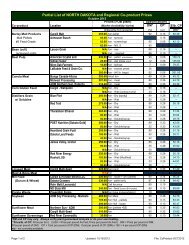Sunflower Production Field Guide - Your "Home Page"
Sunflower Production Field Guide - Your "Home Page"
Sunflower Production Field Guide - Your "Home Page"
Create successful ePaper yourself
Turn your PDF publications into a flip-book with our unique Google optimized e-Paper software.
2<br />
American Indians before colonization of the New<br />
World. Spanish explorers collected sunfl ower in North<br />
America and by 1580, it was a common garden fl ower<br />
in Spain (Figure 2). Early English and French explorers,<br />
fi nding sunfl ower in common use by the American<br />
Indians, introduced it to their respective lands. It<br />
spread along the trade routes to Italy, Egypt, Afghanistan,<br />
India, China and Russia. Sunfl ower developed as<br />
a premier oilseed crop in Russia and has found wide<br />
acceptance throughout Europe. Oilseed sunfl ower has<br />
been an economically important crop in the U.S. since<br />
1966. Before 1966, sunfl ower acreage in the U.S. was<br />
devoted primarily to nonoilseed varieties.<br />
The center of sunfl ower origin has been identifi ed<br />
as limited to the western Plains of North America,<br />
but whether the domesticated type originated in the<br />
Southwest or in the Mississippi or Missouri River<br />
valleys has not been determined. The wild form of the<br />
cultivated sunfl ower is well-known, which is not true<br />
with most of our cultivated crop species today.<br />
■ Figure 2. A 1586 drawing of sunfl ower.<br />
(Mattiolus from Heiser)<br />
The American Indians used sunfl ower as a foodstuff<br />
before the cultivation of corn. Sunfl ower also was used<br />
as a medicinal crop, source of dye, oil for ceremonial<br />
body painting and pottery, and as a hunting calendar.<br />
When sunfl ower was tall and in bloom, the bison fed<br />
on it, and according to stories told, the fat and the<br />
meat were good.<br />
Cultivation of sunfl ower was undertaken by New<br />
World settlers as a supplementary food. Later, sunfl<br />
ower was grown primarily as a garden ornament. It<br />
also was grown as an ensilage crop in the late 1800s<br />
and early 1900s.<br />
Expanded world production of sunfl ower resulted<br />
primarily from development of high-oil varieties by<br />
plant scientists and more recently by the development<br />
of hybrids. Sunfl ower is widely grown in the world<br />
where the climates are favorable and a high quality oil<br />
is desired.<br />
Taxonomy<br />
The cultivated sunfl ower (Helianthus annuus L.) is<br />
one of the 67 species in the genus Helianthus. All<br />
are native to the Americas and most are found in the<br />
U.S. It is a member of the Compositae family and<br />
has a typical composite fl ower (Figure 3). Jerusalem<br />
artichoke (H. tuberosus L.), another species, is grown<br />
on a limited basis for food and livestock feed in the<br />
U.S. A few species are grown as ornamentals and the<br />
rest are weeds, usually found in pastures or disturbed<br />
areas.<br />
The basic chromosome number for the Helianthus<br />
genus is 17. Diploid, tetraploid and hexaploid species<br />
are known. The majority of the species are perennial,<br />
with only about a dozen annual species. Plant breeders<br />
have made interspecifi c crosses within the genus and<br />
have transferred such useful characteristics as higher<br />
oil percentage, cytoplasmic male sterility for use in<br />
production of hybrids, and disease and insect resistance<br />
to commercial sunfl ower.<br />
Growth Stages<br />
The division of growth into vegetative and reproductive<br />
stages as developed by Schneiter and Miller is<br />
shown in Figure 4. This scheme is important as it<br />
gives producers, scientists and the industry a common<br />
basis to discuss plant development.







